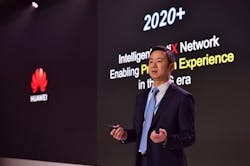Huawei expands Intelligent OptiX Network line with Liquid OTN optical transport, AirPON platforms
Huawei has expanded its Intelligent OptiX Network strategy, unveiled in 2019, with three new products. The Liquid OTN optical transport line leverages the company’s OptiXtrans products, while the AirPON optical access line and embedded AI (eAI) ONT optical network terminals enhance the company’s fiber to the premises (FTTP) options.
The Liquid OTN initiative supports three network operator requirements, according to Huawei:
- Ubiquitous all-optical connectivity via the use of OSUflex containers that support more flexible and granular bandwidth definition. A network hard slice capability supports granularity of 2 Mbps, which the company asserts increases the number of supported connections by 500X.
- Hitless bandwidth adjustment from 2 Mbps to 100 Gbps, which Huawei states will prevent service interruptions and promote the full use of network resources.
- Ultra-low transport latency, at the microsecond level, which it derives from the fact that Liquid OTN “significantly flattens the network transport layers,” in Huawei’s words, as well as provides differentiated latency levels. The capability reduces per-site latency by 70%, says the company.
"Liquid OTN will enable the convergence of transport and access networks,” commented Kevin Huang, vice president and CMO of Huawei's Transmission & Access Network Product Line. “The end-to-end optical connectivity ensures ultra-high bandwidth and ultra-low latency. This will help operators and enterprises build networks with guaranteed good experience to achieve business success in home and enterprise scenarios."
Speaking of access networks, Huawei is targeting its new AirPON line at mobile operators who also want to supply FTTP services. The AirPON portfolio comprises a blade optical line terminal (OLT), the Digital QuickODN (DQ ODN) capabilities found in Huawei's OptiXaccess portfolios, and the company’s OptiXstar home terminals. The product line enables operators to use their existing mobile stations to shorten fiber access runs from 5 km to less than 1 km, a benefit that can shrink capex by 27%, Huawei asserts. Further savings derive from end-to-end ODN visualization for accurate resource management and fault location as well as fast service provisioning, combined with the ability to leverage DQ ODN-based end-to-end pre-connections.
Finally, Huawei positions the new eAI ONT as the industry’s first ONT that can use artificial intelligence to identify service types. The ONT also supports Wi-Fi 6 slicing and intelligent power adjustment.
For related articles, visit the FTTx Topic Center.
For more information on FTTx technologies and suppliers, visit the Lightwave Buyer’s Guide.
To stay abreast of fiber network deployments, subscribe to Lightwave’s Service Providers and Datacom/Data Center newsletters.
About the Author

Stephen Hardy
Editorial Director and Associate Publisher, Lightwave
Stephen Hardy is editorial director and associate publisher of Lightwave and Broadband Technology Report, part of the Lighting & Technology Group at Endeavor Business Media. Stephen is responsible for establishing and executing editorial strategy across the both brands’ websites, email newsletters, events, and other information products. He has covered the fiber-optics space for more than 20 years, and communications and technology for more than 35 years. During his tenure, Lightwave has received awards from Folio: and the American Society of Business Press Editors (ASBPE) for editorial excellence. Prior to joining Lightwave in 1997, Stephen worked for Telecommunications magazine and the Journal of Electronic Defense.
Stephen has moderated panels at numerous events, including the Optica Executive Forum, ECOC, and SCTE Cable-Tec Expo. He also is program director for the Lightwave Innovation Reviews and the Diamond Technology Reviews.
He has written numerous articles in all aspects of optical communications and fiber-optic networks, including fiber to the home (FTTH), PON, optical components, DWDM, fiber cables, packet optical transport, optical transceivers, lasers, fiber optic testing, and more.
You can connect with Stephen on LinkedIn as well as Twitter.
